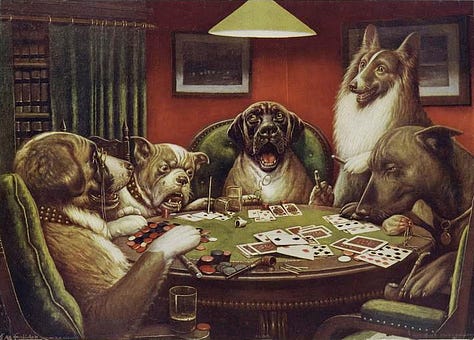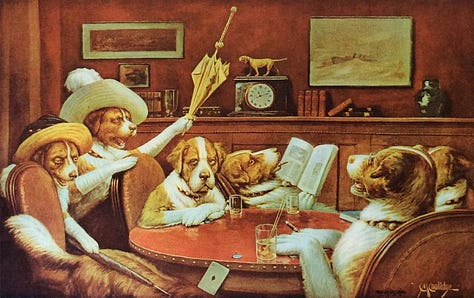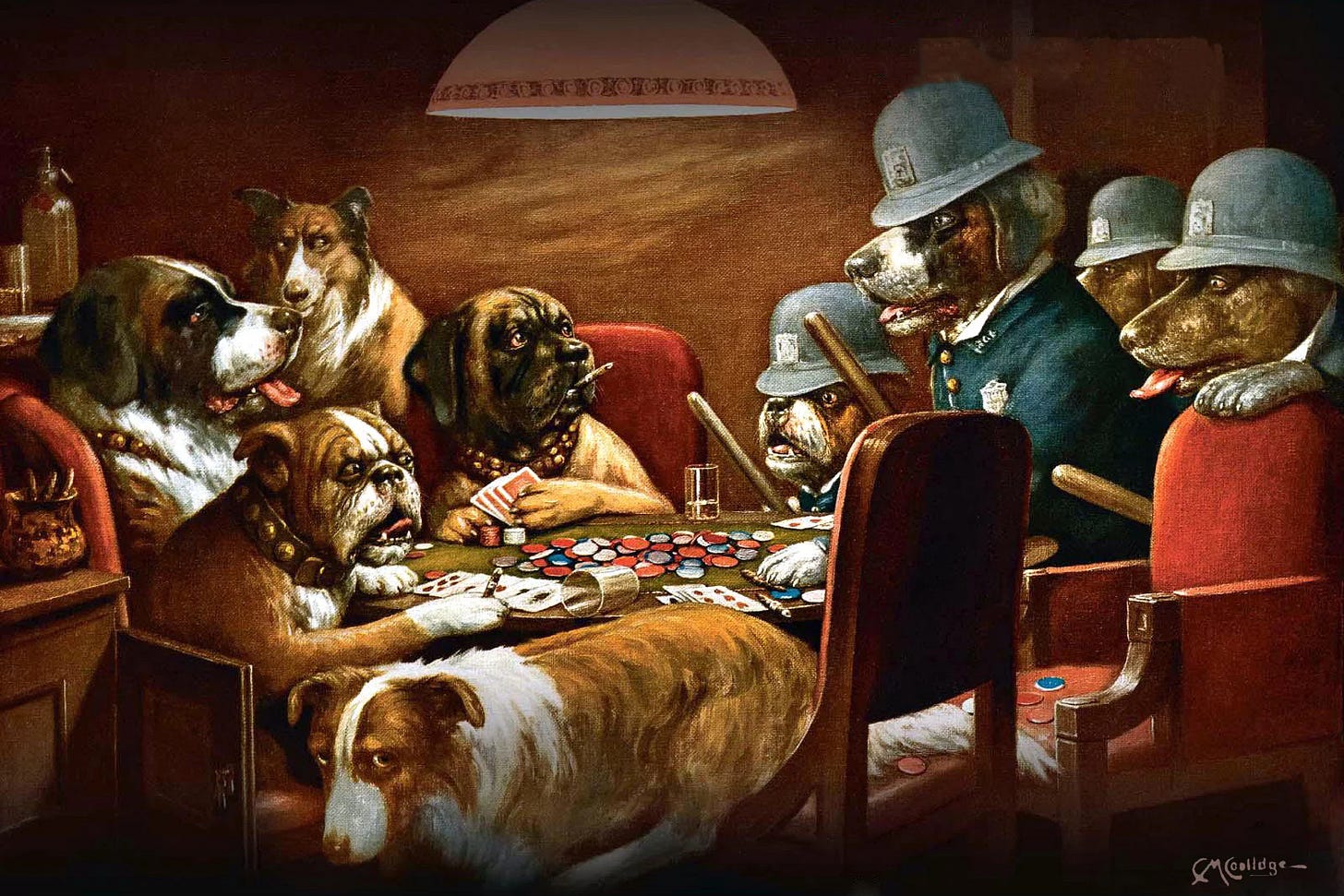Taking the Dogs Playing Poker Paintings Seriously
What Kitsch Dog Art Reveals about Human Subjectivity
Kitsch: Art, objects, or design considered to be in poor taste because of excessive garishness or sentimentality, but sometimes appreciated in an ironic or knowing way. -The Oxford Dictionary of Phrase & Fable
In his 1939 essay Avant-Garde and Kitsch, Clement Greenberg criticized the kitsch aesthetic for being “destined for those who, insensible to the values of genuine culture, are hungry nevertheless for the diversion that only culture of some sort can provide.”
But what if we took kitsch art seriously?
Any example of culture, be it “genuine” or not, is a reflection of the people who made it and, most of all, the people who consume it. This includes everything from popular music to classical, superhero movies to obscure art house cinema. It even includes the kitsch art used for advertisements.
One classic example of kitsch is the series of paintings by Cassius Marcellus Coolidge known as Dogs Playing Poker, which were originally produced to advertise tobacco.





In this post, I take these paintings seriously by examining them through the lenses of evolutionary psychology and psychoanalytic art criticism. I argue that the dogs in these paintings represent the split subjectivity inherent to all human beings.
Consider our selective breeding of the dog through artificial selection. We have, over many generations, observed desirable traits in specific dogs, and we have selected those dogs for breeding. This has caused the traits to become both more common and more intense.
The traits we selectively emphasized in the dog through artificial selection were those traits that we, human beings, value most. So, in this sense, we have bred dogs to be reflections of the best versions of ourselves. That is why we see dogs as being cheery, pure, amiable, and loyal creatures.
Furthermore, our own evolution through natural selection favored those humans who valued those traits because they offered obvious advantages for survival, and it also favored those humans who naturally had close relationships with dogs, since dogs provide protection and hunting skills.
So, our relationship with the dog is evolutionarily intertwined, and this has solidified and amplified the traits we value, as well as our valuation of those traits.
This effect is further intensified with the introduction of artistic representation. The artist, to make his or her point, will exaggerate the subject’s features. Often, when the subject is an animal, it is the human-like traits of the animal that they will emphasize. This is because the audience naturally recognizes and identifies with those traits. Dog art, therefore, culturally reinforces the notion that these traits should be valued.
Although it is true that dogs certainly reflect desirable human-like traits, they are not human beings, so they simultaneously represent undesirable traits, such as beastliness, depravity, savagery, and violence.
This is why it is an insult to call a human a dog or a bitch. This renders them as uncivilized as an animal; it makes them less than human.
So, dogs simultaneously represents two contradictory sets of traits: those that are ideal and those that are debased.
This reflects our own split subjectivity. Humans are animal yet not animal. We are highly civilized yet at the same time we are slaves to our base desires.
Let’s consider how this dynamic is represented in a painting from Coolidge’s Dogs Playing Poker series called A Friend in Need (1903).
In this painting, we see seven dogs of varying breeds sitting around a card table playing poker. The clock in the corner shows it is late at night, just past 1:10 a.m. The dogs are smoking tobacco and drinking alcohol. True to the title, one of the dogs is cheating by passing the ace of clubs under the table to his partner, a bulldog with a similar collar.
This painting shows a group of civilized animals capable of comprehending the somewhat complex rules and mathematics required for a successful game of poker. Furthermore, they are capable of sitting together as a group, without barking at one another and resorting to violence.
However, at the same time, these animals are slaves to their base desires. They are gambling, drinking, and smoking, none of which are particularly smart things to do. Additionally, the cheating bulldog is loyal only to his own breed. He may be sitting at the table with the others, but he does not respect them enough to follow the their rules.
These dogs reflect the best traits and worst traits of humans. We are smart yet dumb, civilized yet uncivilized. We like to think of ourselves as in control, but in reality we are obedient to the master of our unconscious and its animalistic desires.
The other paintings in the series reflect this same split subjectivity. Consider Pinched with Four Aces (1903).
On the left, we see a similar set of dogs sat around a table playing poker. However, another set of dogs on the right, the police, are busting the illegal gambling activities. A dog in the foreground is displaying a look familiar to any dog owner - that of guilt and shame for being caught red-handed.
Again, we see contradictory traits: good dogs on the right and bad dogs on the left, and once more this reflects the split nature of each individual human being. Our subjectivity is almost defined by our conflicting tendencies. The animalistic desires of the Id lead us one way, while the authority, guilt, and shame of the Superego lead us another way.
I said before that all art reflects something about the people who make it and, especially, the people who consume it. I have no evidence to believe that Coolidge was influenced by psychoanalysis, and I think it is very doubtful that he was. Nevertheless, the Freudian concept of split subjectivity was discovered rather than invented, so all I mean to suggest is that Coolidge was, purposefully or not, touching upon the same dynamic that Freud was. By humorously showing dogs behaving as humans, he demonstrated that humans are animals and that, no matter how we try to be civilized, we will never truly be anything more than beasts.








